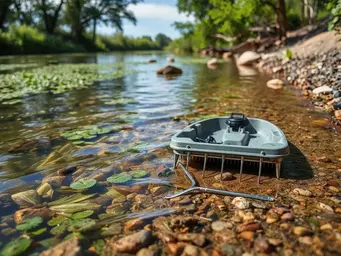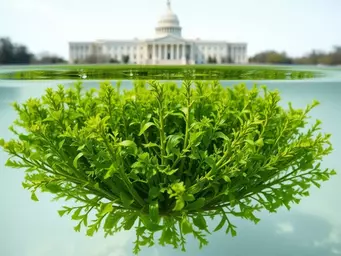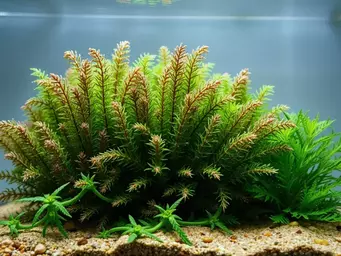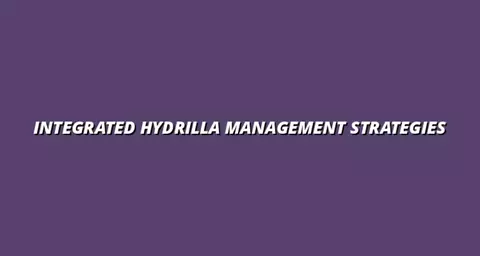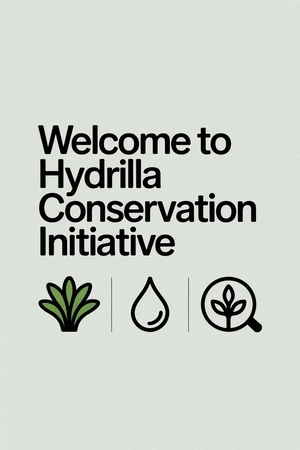What if a single plant could change the balance of an entire ecosystem? Hydrilla, with its rapid growth, poses significant challenges for our waterways. This article unpacks vital strategies for managing this invasive species effectively, emphasizing the importance of integrated approaches over quick fixes.
What You Will Learn
- Integrated management approaches are crucial for effectively controlling hydrilla, combining chemical, biological, and mechanical methods.
- Long-term control strategies enhance ecosystem health, reduce costs, and engage local communities in conservation efforts.
- Understanding the ecological impact of hydrilla is essential for developing targeted management strategies to combat its spread.
- Key control methods include chemical control with herbicides, biological control using natural enemies, mechanical harvesting, and cultural practices to improve water quality.
Integrated Hydrilla Management Strategies
An overview of the key control methods and their combined effectiveness in combating hydrilla.
Key Control Methods
- Chemical Control: Targeted herbicides.
- Biological Control: Natural enemies.
- Mechanical Control: Physical removal.
- Cultural Practices: Nutrient management.
Each method has strengths; combining them is key to success.
Long-Term Benefits
- Enhanced Ecosystem Health: Supports native species.
- Cost-Effectiveness: Reduces need for repeated interventions.
- Community Engagement: Fosters collaboration.
- Sustainable Results: Long-term protection.
Sustainable approach is essential for healthy waterways.
Understanding Integrated Hydrilla Management for Sustainable Results
When it comes to managing hydrilla, a single solution often isn't enough. Instead, we need integrated approaches that address the root causes and dynamics of this invasive plant. Relying on quick fixes, like spot treatments with herbicides, can lead to a cycle of dependency and may even exacerbate the problem over time. I’ve seen this firsthand in my work with the Hydrilla Conservation Initiative, where we've developed comprehensive strategies that focus on long-term control rather than temporary solutions.
Invasive species like hydrilla require a multifaceted response. By combining chemical, biological, and mechanical methods, we can tackle hydrilla effectively while preserving the health of our ecosystems. This integrated management approach not only enhances the effectiveness of our strategies but also fosters a more resilient aquatic environment.
The Importance of Long-Term Control over Quick Fixes
A sustainable approach to hydrilla management is essential for our waterways. Implementing long-term strategies can yield lasting results, protecting native species and maintaining biodiversity. Let’s explore some of the key reasons why long-term control is vital:
- Enhanced Ecosystem Health: Long-term management supports the recovery of native species and their habitats.
- Cost-Effectiveness: Investing in sustainable practices often reduces the need for repeated interventions.
- Community Engagement: Ongoing efforts foster collaboration within local communities and stakeholders.
Ultimately, the goal is to create a balanced ecosystem where hydrilla does not overwhelm our native plants. By committing to long-term solutions, we empower ourselves and our communities to be active participants in preserving our precious waterways.

What is Hydrilla and Its Impact on Ecosystems?
Hydrilla verticillata, commonly known as hydrilla, is a water weed that can grow rapidly and dominate aquatic habitats. Its distinctive whorled leaves and vigorous growth make it a formidable invasive species. When hydrilla proliferates, it can choke waterways, reduce light penetration, and alter the natural ecosystem balance. Have you ever noticed how certain areas of your local lake become overrun with vegetation? That’s the impact of hydrilla at work!
Beyond just physical changes, hydrilla poses both ecological and economic challenges. It can lead to declines in fish populations, interfere with recreational activities like boating and fishing, and increase costs for water management. The long-term implications are significant, and understanding these challenges is the first step in developing effective management strategies. The U.S. Fish and Wildlife Service provides further details on the threats posed by aquatic invasive plants like hydrilla in their draft environmental assessment.
How Invasive Species Like Hydrilla Affect Aquatic Ecosystems
The presence of invasive species like hydrilla can disrupt the delicate balance of aquatic ecosystems. Invasive plants and animals often outcompete native species for resources, leading to declines in local biodiversity. Here are a few ways hydrilla contributes to these challenges:
- Disruption of Food Chains: Hydrilla can alter the availability of food for native fish and wildlife.
- Reduced Water Quality: As hydrilla overgrows, it can lead to decreased oxygen levels in the water.
- Altered Habitats: Native plants and animals may struggle to survive as they are shaded out and outcompeted.
Recognizing the broader implications of hydrilla is crucial for anyone involved in aquatic management. By understanding how these invasive species affect our ecosystems, we can create more targeted and effective strategies to combat their spread. The DOI Invasive Species Strategic Plan outlines comprehensive approaches to managing such threats.
Key Control Methods in Integrated Hydrilla Management
Now that we've established the significance of an integrated approach, let's delve into some effective control methods for managing hydrilla. These strategies not only target the plant itself but also consider the ecological health of our waterways.
Remember, each method has its strengths and limitations, so combining them is key to success! Here’s an overview of the control methods you might consider:
- Chemical Control: Utilizing herbicides responsibly within an integrated framework.
- Biological Control: Employing natural enemies to help reduce hydrilla populations.
- Mechanical Control: Implementing harvesting techniques to physically remove the plant.
- Cultural Practices: Using methods like nutrient management to make environments less favorable for hydrilla.
By integrating these methods, we can foster healthier ecosystems and build resilient waterways for future generations. For more detailed information on specific management techniques, the California Department of Food and Agriculture provides resources on hydrilla control. Let's work together to combat hydrilla and protect our precious aquatic habitats!
Did You Know?
According to the U.S. Fish and Wildlife Service, invasive species like hydrilla can reduce native biodiversity by over 50% in affected areas. This alarming statistic highlights the urgent need for effective and integrated management strategies to combat their spread.
Frequently Asked Questions About Hydrilla Management
What is Hydrilla and why is it a problem?
Hydrilla verticillata is a rapidly growing invasive aquatic plant. It chokes waterways, reduces light penetration, alters natural ecosystem balance, decreases oxygen levels, disrupts food chains, and displaces native species, causing ecological and economic challenges.
Why are integrated approaches crucial for managing hydrilla?
A single solution is often inadequate for effective hydrilla management. Integrated approaches combine chemical, biological, and mechanical methods to address root causes, enhance effectiveness, and foster a more resilient aquatic environment, preventing dependency on quick fixes.
What are the key control methods for hydrilla?
Key control methods include chemical control (targeted herbicides), biological control (natural enemies), mechanical control (physical removal like harvesting), and cultural practices (nutrient management to create unfavorable conditions).
What are the long-term benefits of integrated hydrilla management?
Long-term benefits include enhanced ecosystem health (supporting native species), cost-effectiveness (reducing the need for repeated interventions), community engagement (fostering collaboration), and sustainable results (long-term protection of waterways).
How can communities get involved in hydrilla management?
Community engagement is a vital aspect of long-term control. Local communities and stakeholders can participate in ongoing efforts, contribute to monitoring, and collaborate with initiatives like the Hydrilla Conservation Initiative to preserve waterways.
Summarizing Effective Strategies for Integrated Hydrilla Management
In our journey to combat hydrilla, we've discovered that employing a combination of methods is crucial for effective control. Integrated hydrilla management isn't just about quick fixes; it’s about creating a comprehensive strategy that addresses the underlying issues. By merging chemical, biological, and mechanical methods, we can achieve sustainable results that benefit our ecosystems over the long term.
Here are the key strategies we've found to be effective:
- Chemical Control: Utilizing targeted herbicides in conjunction with biological agents ensures a multifaceted approach.
- Mechanical Harvesting: Techniques such as diver-assisted suction harvesting (DASH) play a vital role in physically removing hydrilla.
- Cultural Practices: Implementing nutrient remediation and creating buffer zones helps prevent the spread of hydrilla.
- Continuous Monitoring: Keeping a close eye on water quality and hydrilla growth allows for timely interventions.
Each of these strategies works together to form a robust defense against this invasive species, showing that a unified approach leads to greater success in the long run. At the Hydrilla Conservation Initiative, we strive to empower environmental professionals with these insights, fostering a collaborative effort to protect our waterways.
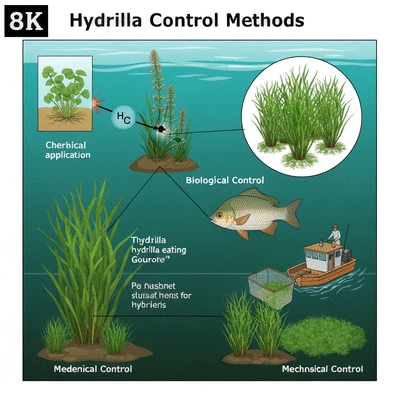
Taking Action: Your Next Steps in Hydrilla Management
Now that we've explored effective strategies for managing hydrilla, it’s time for you to take action! Start by assessing your unique situation—consider the specific challenges and opportunities within your local ecosystem. Use the decision framework we've provided to implement integrated hydrilla management effectively. Remember, every small step you take contributes to a larger impact on our environment.
I encourage you to share your experiences and insights in the comments below! Your stories can inspire others in our community and foster collective learning. Together, we can make a difference in the fight against invasive species like hydrilla!
Recap of Key Points
Here is a quick recap of the important points discussed in the article:
- Implement integrated approaches that combine chemical, biological, and mechanical methods for effective hydrilla management.
- Focus on long-term control strategies rather than quick fixes to protect native species and maintain ecosystem health.
- Utilize targeted herbicides responsibly alongside biological agents for a multifaceted approach to hydrilla control.
- Engage in continuous monitoring of water quality and hydrilla growth to allow for timely interventions.

